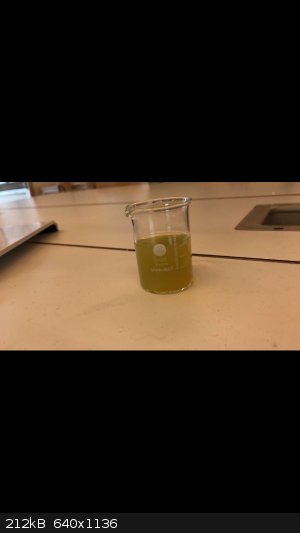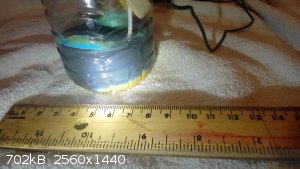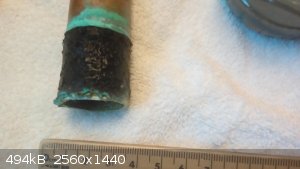
OliverKenwood - 26-4-2018 at 10:21
Electrolysis of aqueous 1 mol/dm3 HCl with copper anode and graphite rod cathode was run for 10 minutes at 15 V. Blue-ish solution in the
u-tube was obtained and put in a beaker for testing. 1 M NaOH (aq) was added but when the first drop was added, greenish precipitate was formed which
quickly redissolved due to unreacted HCl. After many drops of NaOH solution turned yellowish-green cloudy precipitate-like solution. This was
performed with fresh NaOH, yielding same result.
The expected compound was copper(II)hydroxide but no such blue solid was formed. Temperature of the solution was below 30 degrees Celsius which
discloses the possibiltiy of copper(II)oxide being formed as copper(II)hydroxide decomposes after the heat. If someone here knows what is going on I
will be happy to know!

MrHomeScientist - 26-4-2018 at 10:53
What was your source of hydrochloric acid? Hardware store acid is usually contaminated with iron, which would give brownish/yellow precipitates with
hydroxide.
unionised - 26-4-2018 at 11:20
In the presence of a lot of chloride you can get a mixture of Cu(I) and Cu(II) compounds.
I wouldn't expect that with just 1M HCl, but the colour of the hydroxide would be about right.
OliverKenwood - 26-4-2018 at 11:41
Hydrochloric acid was lab grade acid thus contamination wasnt a problem. The problem was maybe as unionized said, in the excess chloride but that
remains to be tested next week. Any other suggestions?
unionised - 26-4-2018 at 12:43
You could repeat the experiment, but add an oxidant before you add the alkali.
Perhaps hydrogen peroxide since you will be able to destroy any excess by simply boiling the solution for a while.
Air would work, but it's slow.
walruslover69 - 26-4-2018 at 13:51
https://en.wikipedia.org/wiki/Copper(I)_hydroxide
The description of copper(1) hydroxide seems to match your picture perfectly. It still seems vary odd. Copper(1) salts are usually kinda tricky to
make even on purpose.
Vomaturge - 27-4-2018 at 00:10
I think Unionised is right. I happen to be doing something similar right now, and am just as confused by it as the OP. A few days ago, I dissolved
half a teaspoon of salt (~2.5 cc, I know this is a lousy way to measure a loose powder, but I currently don't have a good way to weigh such small
items) in 100ml of water. I dipped a piece of copper tubing into the solution as a consumable anode, and used a piece of copper wire as the cathode.
3.8v was applied. The current initially was about 250 mA, but that fell as corrosion built up on the anode. I only ran it intermittently, unplugging
it during the night or when I needed the power supply for other things.
When sodium chloride is used instead of hydrochloric acid, the precipitates form during electrolysis. You might think of copper chloride and sodium
hydroxide (or at least the constituent ions of these) being formed simultaneously in the cell, and then reacting.
Here is a picture, taken after power had been applied for a total of about 16 hours Note the layer of mostly orange precipitate, with some blue as
well:

Here is a picture of the copper tube, covered in unknown copper compounds. By the time these two pictures were taken, this deposit had limited current
to about 70 mA. Scraping it off restored the current to 250 mA:

I think I have both copper1 and copper2 compounds in the cell, but I'm just assuming that due to the colors visible.
[urlhttp://webpages.charter.net/dawill/tmoranwms/Chem_Cu.html]this webpage[/url] says that electrolysis of copper in a chloride solution "precipitates
CuOH, which being unstable autodehydrates to the yellow to orange Cu2O." This paper's abstract describes a similar formation of Cu2O with the hydroxide as an "intermediate". I suppose that could also account for the yellow stuff, if
it's not the hydroxide itself.It does look a lot like the copper1 oxide shown at 3:17 in this video.
Whatever it is, this precipitate can be dried on paper without losing its yellow color. Since I'm doing this experiment to make black copper2 oxide, I
am planning on heating most of the precipitate in air to dehydrate and oxidize it further.
Metallus - 27-4-2018 at 03:11
Reduction/oxidation on copper will often yield both Cu(I) and Cu(II).
Afterall if you think about it, Cu(I) is produced by comproportionation of Cu and Cu (II), and you happen to have both:
Cu + CuCl2 --> 2 CuCl
https://en.wikipedia.org/wiki/Copper(I)_chloride
AJKOER - 30-4-2018 at 11:28
My advice try to avoid complexing issues of copper ions with chloride,..., by perhaps repeating the experiment with carbonated water in place of HCl
using the copper/carbon electrodes. Not sure if adding a small amount of NaHCO3 (or KHCO3) to serve as an electrolyte is a good idea as this may
result in a mixed salt with sodium, Na2CO3.CuCO3.3H2O (see http://copper.atomistry.com/cupric_carbonates.html ), but one could target this salt as the product of interest for the experiment.
Otherwise, expect an insoluble basic copper carbonate, either Cu(OH)2.CuCO3 or Cu(OH)2.2CuCO3. Strong heating to 300 C reduces it to CuO. Adding acid
yields CO2 (measure volume generated).
Source: see https://en.wikipedia.org/wiki/Basic_copper_carbonate .
[Edited on 30-4-2018 by AJKOER]

